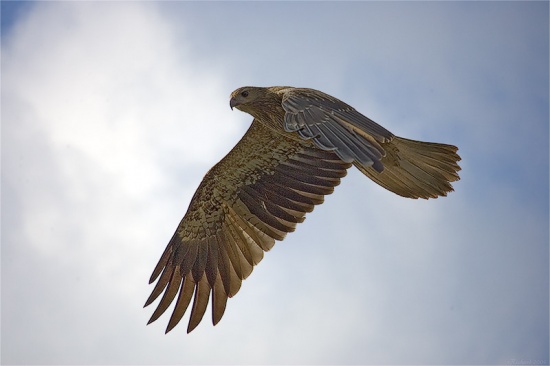| Line 1: | Line 1: | ||
;[[:Category:Haliastur|Haliastur]] sphenurus | ;[[:Category:Haliastur|Haliastur]] sphenurus | ||
[[Image:Whistling_Kite.jpg|thumb|550px|right|Photo by RMD<br />Photo taken: Australia.]] | [[Image:Whistling_Kite.jpg|thumb|550px|right|Photo by RMD<br />Photo taken: Australia.]] | ||
| − | + | ||
==Identification== | ==Identification== | ||
| − | ==Distribution | + | 50–60 cm; females are larger and heavier than males. Pale buff head, breast and tail, brown wings, black flight feathers, bone-coloured legs and feet. Immature birds are a heavily-streaked reddish-brown with prominent pale spots on the wings. |
| − | Australasia. Breeds in eastern New Guinea, New Caledonia and widely distributed in Australia where it occurs virtually throughout the mainland. Resident over most of range but nomadic in parts of Australia. | + | |
| − | Vagrants recorded on Tasmania and King Island. | + | ==Distribution== |
| + | Australasia. Breeds in eastern [[New Guinea]], [[New Caledonia]] and widely distributed in [[Australia]] where it occurs virtually throughout the mainland. Resident over most of range but nomadic in parts of Australia. | ||
| + | Vagrants recorded on [[Tasmania]] and [[King Island]]. | ||
| + | ==Taxonomy== | ||
| + | |||
==Habitat== | ==Habitat== | ||
| − | Open woodland, grassland with scattered trees, lakesides, swamps and riverine woodland | + | Open woodland, grassland with scattered trees, lakesides, swamps and riverine woodland. |
==Behaviour== | ==Behaviour== | ||
| + | The diet includes small mammals, birds, fish, reptiles, amphibians, crustaceans, insects and carrion. | ||
| + | |||
| + | The nest is a bulky platform made of sticks and lined with green leaves, placed in an upright fork of a tall tree. 2–3 bluish-white eggs, which are sometimes covered with reddish-brown blotches, are laid and are incubated for 35–40 days. After a further 44–54 days the young fledge. | ||
| + | |||
==External Links== | ==External Links== | ||
{{GSearch|Haliastur+sphenurus}} | {{GSearch|Haliastur+sphenurus}} | ||
*[http://www.aviceda.org/abid/birdimages.php?action=birdspecies&fid=42&bid=567 View more images of this species on the ABID] | *[http://www.aviceda.org/abid/birdimages.php?action=birdspecies&fid=42&bid=567 View more images of this species on the ABID] | ||
| − | [[Category:Birds]][[Category:Haliastur]] | + | [[Category:Birds]][[Category:Haliastur]][[category:incomplete]] |
Revision as of 15:10, 23 July 2008
- Haliastur sphenurus
Identification
50–60 cm; females are larger and heavier than males. Pale buff head, breast and tail, brown wings, black flight feathers, bone-coloured legs and feet. Immature birds are a heavily-streaked reddish-brown with prominent pale spots on the wings.
Distribution
Australasia. Breeds in eastern New Guinea, New Caledonia and widely distributed in Australia where it occurs virtually throughout the mainland. Resident over most of range but nomadic in parts of Australia. Vagrants recorded on Tasmania and King Island.
Taxonomy
Habitat
Open woodland, grassland with scattered trees, lakesides, swamps and riverine woodland.
Behaviour
The diet includes small mammals, birds, fish, reptiles, amphibians, crustaceans, insects and carrion.
The nest is a bulky platform made of sticks and lined with green leaves, placed in an upright fork of a tall tree. 2–3 bluish-white eggs, which are sometimes covered with reddish-brown blotches, are laid and are incubated for 35–40 days. After a further 44–54 days the young fledge.




